Energy
How Much Has the Shale Boom Boosted GDP During the Great Recovery?

Published:
Last Updated:

If you have been out to West Texas or driven through much of North Dakota where unconventional oil drilling has taken off, it’s obvious that a lot of money gone into the effort of drilling. If a lot of money is going in, it’s a good bet a lot more is coming out. The shale boom from horizontal drilling and hydraulic fracturing has not only added greatly to the oil and gas companies, but it has also created many new millionaires via royalty payments. It also has helped to modify some of the trade losses in the U.S. international trade balance.
Not everyone is a fan of fracking, but what has been hard to deny is that fracking has helped boost gross domestic product (GDP) in multiple pockets in the United States. A new report from the Federal Reserve Bank of Dallas has tried to quantify what the shale boom has contributed to GDP over 10 years. This also happens to be the recovery period after the Great Recession.
The obvious impact is that the oil-producing regions have been beneficiaries, and the end result is that shale has led to both large employment gains and to gains in output. While quantifying the benefits of the shale boom is difficult, the Dallas Fed has shown that the boom may have added 1% to U.S. GDP from 2010 to 2015, and there are greater long-term data as well.
Texas and North Dakota have realized the bulk of the production gains. The Dallas Fed showed that North Dakota’s output has risen from 235,000 barrels per day at the start of 2010 to 1.4 million barrels per day most recently. The output in Texas has risen from 1.1 million barrels per day to 5.0 million barrels per day, and Texas now produces over half of the nation’s shale oil.
One issue to consider is that United States has been migrating from a crude importer to a crude exporter. Exports add to GDP over time, while imports take away from GDP. Back in 2006, the United States imported roughly twice as much oil as it produced. The Dallas Fed maintained that the share has declined to about two-thirds of domestic production, and it showed that the U.S. petroleum trade balance had narrowed from −$492 billion back in 2005 to only −$136 billion as of 2018, now that exports are up more than five times going back to 2006 (less than 500,000 barrels per day at the end of 2005 to 3 million barrels per day as of July 2019).
The Dallas Fed report noted:
The widespread use of horizontal drilling and hydraulic fracking started in the mid-2000s with natural gas production in the Barnett Shale in North Central Texas. By the start of this decade, the technique had been applied to several shale oil formations — most notably, the Permian Basin in West Texas and New Mexico — with remarkable results. … U.S. shale oil production rose by more than 7 million barrels per day from 2010 to 2019. Total U.S. oil production, which had declined to 4.4 million barrels per day in mid-2005, has since nearly tripled to 12.2 million barrels per day.
Another observation on top of GDP growth is that the increased production also has lowered the price of fuel for U.S. consumers and the rest of the world. That allows for spending on other items. The report said:
We find that the shale boom caused both oil prices and oil product prices to fall. Although refiners amped up output by using a greater amount of their refining capacity, the sheer magnitude of crude production was so high that not all the oil could be absorbed, leading to a significant decline in imports. The decline in imports generated a major improvement in the trade balance for oil, amounting to about 1 percent of GDP.
Given that crude oil accounts for the bulk of the marginal cost of producing fuels—such as diesel and gasoline—the model shows that the shale boom led to 14 percent lower fuel prices in the U.S. and in the rest of the world. The magnitude of the decline in fuel prices was similar in the U.S. and the rest of the world because, unlike with crude oil, there had been free trade in refined products such as fuels.
All in, the Dallas Fed is suggesting that the actual increase of all GDP was about 10% of the gains despite the oil sector’s total weighting of less than 1.5% of the total economy.
The thought of burdening your family with a financial disaster is most Americans’ nightmare. However, recent studies show that over 100 million Americans still don’t have proper life insurance in the event they pass away.
Life insurance can bring peace of mind – ensuring your loved ones are safeguarded against unforeseen expenses and debts. With premiums often lower than expected and a variety of plans tailored to different life stages and health conditions, securing a policy is more accessible than ever.
A quick, no-obligation quote can provide valuable insight into what’s available and what might best suit your family’s needs. Life insurance is a simple step you can take today to help secure peace of mind for your loved ones tomorrow.
Click here to learn how to get a quote in just a few minutes.
Thank you for reading! Have some feedback for us?
Contact the 24/7 Wall St. editorial team.